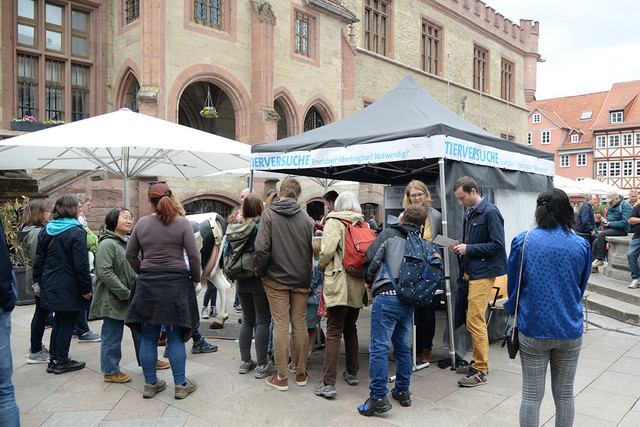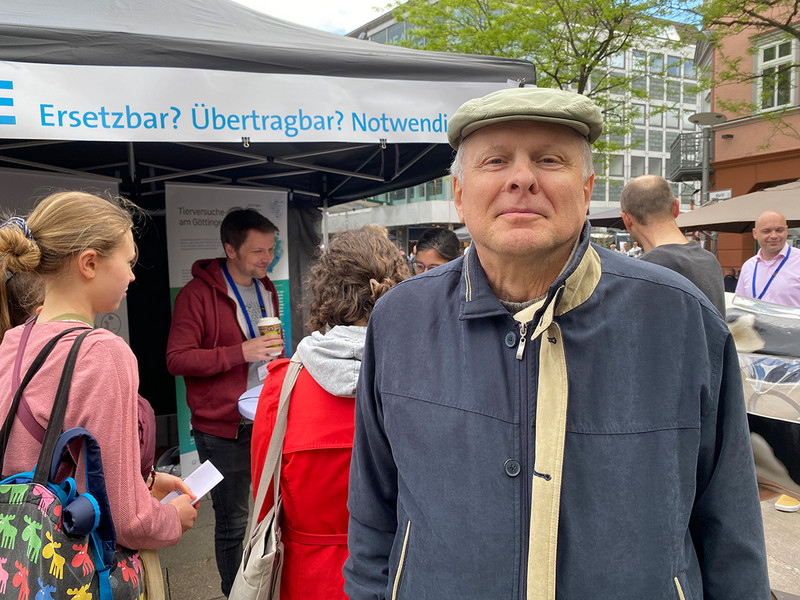Science goes City - Information about animal experiments




Animal testing in research is a topic that is often less about facts and more about emotionally charged opinions. This is also due to the fact that scientists are often reluctant to speak out on the subject, if at all. The scientific institutions on the Göttingen Campus have committed themselves to transparency in dealing with animal experiments and took the "Science goes City" day of action in Göttingen as an opportunity to report on their research with animals at a stand at the Gänseliesel.
As there are a number of myths surrounding the topic of animal testing, it is all the more important to engage in dialogue and provide information. At "Sciences goes City", the DPZ, together with other institutes on the Göttingen Campus, provided information with the help of a dialogue wall, for example. This addressed common questions on the subject of animal testing, such as Where does the laboratory animal come from, who controls animal testing and are cosmetic products tested on animals?
Kowser Khoshandam and Elias Kirchhof enquire at our stand: "I thought there were cosmetics that were tested on animals because they are always advertised as 'cruelty-free'," says Khoshandam. The rumour persists that animal testing is still carried out in Germany and Europe to test cosmetics. However, it has been illegal in Germany to test decorative cosmetics on animals since 1986. This includes make-up, nail varnish and similar products. In 1998, this ban was extended in the Animal Welfare Act to include skin care cosmetics such as shower gel or creams. A few years later, EU-wide bans were imposed, which also prohibit the marketing of cosmetics tested on animals and the use of data from animal testing for cosmetics. Khoshandam and Kirchhof have equipped themselves with the current "Compass Animal Testing", a booklet from the information initiative Understanding Animal Testing, to learn even more about animal testing. For example, in which areas it is not yet possible to dispense with animal testing despite the use of alternative methods.
For example, in research areas on the Göttingen Campus. Animal experiments are carried out at the German Primate Centre, the Max Planck Institute for Multidisciplinary Natural Sciences, the University Medical Centre Göttingen and the Georg August University. Scientists there conduct research into pressing biomedical and agricultural science questions, for which animal experiments represent a small but essential part of the range of methods used. Various animal species are used, for example cattle, goats, poultry and fish in the agricultural sciences and mice, rats and marmosets in hearing research.
The aim of the researchers there is to enable deaf people to hear as naturally as possible. They are in the process of developing a new type of hearing prosthesis, an optical cochlear implant, a model of which they presented at "Science goes City". The implant is designed to work as follows: The sound reaching the ear is converted into light impulses, which then stimulate the auditory nerve cells in the ear. However, as nerve cells react primarily to electrical impulses and not to light, the auditory nerve cells in the ear must first be optogenetically modified, i.e. "light switches" must be introduced. This has already been successful in gerbils, and whether it also works in a species that is closer to humans in terms of evolutionary biology is currently being tested on common marmosets. If it works, this would pave the way for the treatment of patients. Visitor to the stand Rainer Rehbein found the direct dialogue with the researchers enriching: "Normally you only learn about animal experiments through the media, the direct contact with the researchers was great. He already had prior knowledge about the optical cochlear implant from television reports. He hopes that the research will progress more quickly, as he says: "The better you can hear, the better you can often integrate into a community. It's important to be able to hear so that you can have a say".
The scientists got into dialogue with many people, with those who otherwise have no contact with research, with young people who might like to work in research themselves one day and also with opponents of animal testing. The central location in Göttingen's city centre was ideal for reaching as many people as possible.


